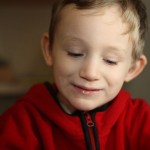The Mystery of Autism
 Calling Autism a disorder is a bit misleading. The term “Autism” is really a category for a spectrum of disorders including Autistic disorder, Asperger syndrome, Childhood Disintegrative disorder, Rett syndrome, and Pervasive Developmental disorder. Those afflicted with these disorders often share difficulties in communication and social interactions. Some cannot speak or maintain eye contact. Some have repetitive routines and an obsessive attention to certain details. In the United States, an estimated 1 in 110 children has an autism spectrum disorder and for the past several years, it’s been on the minds of many researchers around the world.
Calling Autism a disorder is a bit misleading. The term “Autism” is really a category for a spectrum of disorders including Autistic disorder, Asperger syndrome, Childhood Disintegrative disorder, Rett syndrome, and Pervasive Developmental disorder. Those afflicted with these disorders often share difficulties in communication and social interactions. Some cannot speak or maintain eye contact. Some have repetitive routines and an obsessive attention to certain details. In the United States, an estimated 1 in 110 children has an autism spectrum disorder and for the past several years, it’s been on the minds of many researchers around the world.
For the past several years, the cause and treatment options for autism have escaped researchers. When faced with certain mysteries, it’s often a process of figuring out what happened genetically, finding that change in those with the disorder, and making conclusions. So why is autism so different? It’s not a simple mystery it seems. Instead of a single change, it seems that autism has multiple culprits, making them all the more difficult to track down.
It’s been long known that genes play an important role in the development and onset of autism and that of some 90% of autism cases have linked back to genetics. When genetics are involved, a researcher hopes to find a single mutation that is evident in every example of the case. With cases of autism, mutations have been found in those with the disorder, but also in those without. Just to top it all off, some gene variants linked to risks of autism have also been linked to other psychiatric disorders such as manic-depressive illness or schizophrenia. Finding a simple genetic change does not seem like the answer.
Researchers are instead using any genetic findings as a starting point to identify where these mutated genes come into play. Recent findings have identified rare mutations in genes involved with common biological pathways and networks including how the brain develops and functions; how the brain cells communicate; and in the growth of nerve cells or in intercellular signaling. These clues have become targets for new approaches for autism treatment.
Some laboratories are using new technologies to look closer into the genome. Some laboratories have started to sequence all protein coding regions, some going as far as sequencing a person’s whole genome to highlight only differences between people with autism and those without.
Taking all the variants discovered together, they are only true for a small number of cases. So what happens if we step back? Rather than looking at the genetic code itself, why not look at the gene as a whole? In some cases, there are copy number differences. Studies have found variations in DNA where there are either missing segments or segments that have been repeated several times. Overall, these segments appear to be relatively harmless but some have been implicated in disorders. In 2007, here, at Cold Spring Harbor Laboratory, scientists have found evidence that suggests that copy number variants may be associated with the symptoms of autism. In Nature, a group of researchers compared over a thousand autistic subjects with over a thousand healthy subjects. They found that dozens of DNA sections were either missing or duplicated, and that some of these changes weren’t inherited, they were new. It was then decided that it’s quite possible that autism does not have only one or two genetic risk factors, but instead has hundreds. Studies to date have identified at least 100 strong candidate risk genes for autism.
What is being done now is connecting these variants to pathways. Despite the large amount of variants, the protein products from these variants participate in pathways that regulate brain development and function.
Scientists at the Broad Institute in Cambridge, Mass., are using new sequencing technology to compare genomes between those with autism and those without, concentrating on single point mutations that will contribute to an autism risk. At Emory University in Atlanta, scientists are using twins in studies on white blood cells and their reflections in the brain. They are looking at dozens of sites in which DNA has been chemically altered, or methylated. The group is looking at trying to identify autism in infants, instead of 2 or 3 year-olds since the brain is more flexible at younger ages. The group is hoping that with intense behavioral interventions, autism’s effects can be overcome by creating new mental pathways.
Pushing genetics aside, there have been cases of identical twins that do not share the disorder, suggesting important environmental factors as well. All researchers know now is that these findings might possibly point to multiple molecular issues leading to the same outcome.
For more information, check out Science New’s, “The Unusual Suspects,” published this past week.
| Print article | This entry was posted by Jennifer Aiello on November 2, 2010 at 4:48 pm, and is filed under G2C Online. Follow any responses to this post through RSS 2.0. You can skip to the end and leave a response. Pinging is currently not allowed. |
